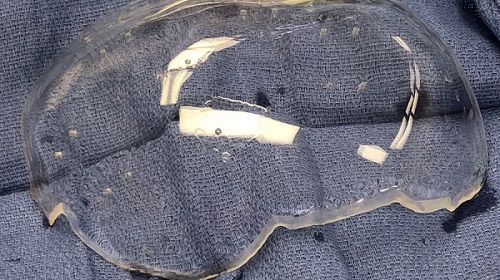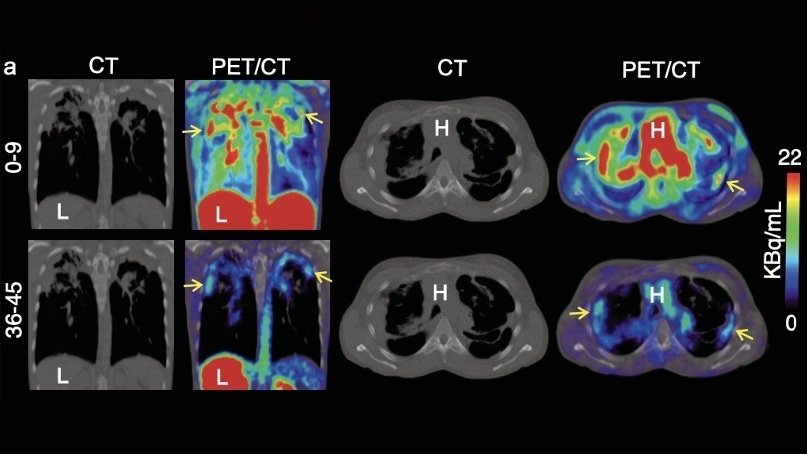Functional Ultrasound Imaging Records Brain Activity through Transparent Skull Implant
|
By MedImaging International staff writers Posted on 30 May 2024 |

Functional brain imaging, which captures brain activity data by measuring changes in blood flow or electrical impulses, provides crucial insights into brain function for both healthy individuals and those with neurological disorders. However, existing techniques like functional magnetic resonance imaging (fMRI) and intracranial electroencephalography (EEG) have limitations, including low resolution, lack of portability, and the requirement for invasive surgery. Functional ultrasound imaging (fUSI) is now emerging as a sensitive and precise alternative that could address these issues.
In the first study of its kind led by the Keck School of Medicine of USC (Los Angeles, CA, USA) and the California Institute of Technology (Caltech, Pasadena, CA, USA), researchers have designed and implanted a transparent window into the skull of a patient. This was followed by the use of fUSI to gather high-resolution brain imaging data through this window. Preliminary results indicate that this non-invasive method could revolutionize patient monitoring, clinical research, and our understanding of brain function.
Building on earlier work where the team developed specialized ultrasound sequences for measuring brain function and optimizing brain-computer interfaces, they tested various transparent skull implants on rats. A thin window made of polymethyl methacrylate (PMMA), similar to plexiglass, provided the best imaging clarity. Subsequently, a custom implant was created to explore the potential of fUSI in a research participant recovering from a traumatic brain injury (TBI).
Prior to the reconstructive surgery, the researchers fine-tuned fUSI parameters using a phantom (a device used to test medical imaging equipment) and animal models. They then monitored the patient’s brain activity through fUSI during tasks performed both pre-surgery and post-implantation of the clear window. fUSI not only offered sharper resolution than fMRI but, unlike intracranial EEG, it avoids the need for internal brain electrodes. It also costs less than these methods and could provide clinical benefits over opaque skull implants.
The novel technique also holds promise for broader studies on TBI and other neurological conditions, as well as the ability to observe the healthy brain's management of cognitive, sensory, motor, and autonomic functions. Although fUSI and the clear implant remain experimental pending clinical trials, the research team is actively working to refine their fUSI techniques to enhance imaging resolution further. They plan future studies involving more participants to better establish the connection between specific brain functions and fUSI data.
“This is the first time anyone had applied functional ultrasound imaging through a skull replacement in an awake, behaving human performing a task,” said Charles Liu, MD, PhD, a professor of clinical neurological surgery, urology and surgery at the Keck School of Medicine and director of the USC Neurorestoration Center. “The ability to extract this type of information noninvasively through a window is pretty significant, particularly since many of the patients who require skull repair have or will develop neurological disabilities. In addition, ‘windows’ can be surgically implanted in patients with intact skulls if functional information can help with diagnosis and treatment.”
Related Links:
Keck School of Medicine of USC
Caltech
Latest Ultrasound News
- Wireless Chronic Pain Management Device to Reduce Need for Painkillers and Surgery
- New Medical Ultrasound Imaging Technique Enables ICU Bedside Monitoring
- New Incision-Free Technique Halts Growth of Debilitating Brain Lesions
- AI-Powered Lung Ultrasound Outperforms Human Experts in Tuberculosis Diagnosis
- AI Identifies Heart Valve Disease from Common Imaging Test
- Novel Imaging Method Enables Early Diagnosis and Treatment Monitoring of Type 2 Diabetes
- Ultrasound-Based Microscopy Technique to Help Diagnose Small Vessel Diseases
- Smart Ultrasound-Activated Immune Cells Destroy Cancer Cells for Extended Periods
- Tiny Magnetic Robot Takes 3D Scans from Deep Within Body
- High Resolution Ultrasound Speeds Up Prostate Cancer Diagnosis
- World's First Wireless, Handheld, Whole-Body Ultrasound with Single PZT Transducer Makes Imaging More Accessible
- Artificial Intelligence Detects Undiagnosed Liver Disease from Echocardiograms
- Ultrasound Imaging Non-Invasively Tracks Tumor Response to Radiation and Immunotherapy
- AI Improves Detection of Congenital Heart Defects on Routine Prenatal Ultrasounds
- AI Diagnoses Lung Diseases from Ultrasound Videos with 96.57% Accuracy
- New Contrast Agent for Ultrasound Imaging Ensures Affordable and Safer Medical Diagnostics
Channels
Radiography
view channel
AI Detects Fatty Liver Disease from Chest X-Rays
Fatty liver disease, which results from excess fat accumulation in the liver, is believed to impact approximately one in four individuals globally. If not addressed in time, it can progress to severe conditions... Read more
AI Detects Hidden Heart Disease in Existing CT Chest Scans
Coronary artery calcium (CAC) is a major indicator of cardiovascular risk, but its assessment typically requires a specialized “gated” CT scan that synchronizes with the heartbeat. In contrast, most chest... Read moreMRI
view channel
New MRI Technique Reveals Hidden Heart Issues
Traditional exercise stress tests conducted within an MRI machine require patients to lie flat, a position that artificially improves heart function by increasing stroke volume due to gravity-driven blood... Read more
Shorter MRI Exam Effectively Detects Cancer in Dense Breasts
Women with extremely dense breasts face a higher risk of missed breast cancer diagnoses, as dense glandular and fibrous tissue can obscure tumors on mammograms. While breast MRI is recommended for supplemental... Read moreNuclear Medicine
view channel
Novel Bacteria-Specific PET Imaging Approach Detects Hard-To-Diagnose Lung Infections
Mycobacteroides abscessus is a rapidly growing mycobacteria that primarily affects immunocompromised patients and those with underlying lung diseases, such as cystic fibrosis or chronic obstructive pulmonary... Read more
New Imaging Approach Could Reduce Need for Biopsies to Monitor Prostate Cancer
Prostate cancer is the second leading cause of cancer-related death among men in the United States. However, the majority of older men diagnosed with prostate cancer have slow-growing, low-risk forms of... Read moreGeneral/Advanced Imaging
view channel
CT Colonography Beats Stool DNA Testing for Colon Cancer Screening
As colorectal cancer remains the second leading cause of cancer-related deaths worldwide, early detection through screening is vital to reduce advanced-stage treatments and associated costs.... Read more
First-Of-Its-Kind Wearable Device Offers Revolutionary Alternative to CT Scans
Currently, patients with conditions such as heart failure, pneumonia, or respiratory distress often require multiple imaging procedures that are intermittent, disruptive, and involve high levels of radiation.... Read more
AI-Based CT Scan Analysis Predicts Early-Stage Kidney Damage Due to Cancer Treatments
Radioligand therapy, a form of targeted nuclear medicine, has recently gained attention for its potential in treating specific types of tumors. However, one of the potential side effects of this therapy... Read moreImaging IT
view channel
New Google Cloud Medical Imaging Suite Makes Imaging Healthcare Data More Accessible
Medical imaging is a critical tool used to diagnose patients, and there are billions of medical images scanned globally each year. Imaging data accounts for about 90% of all healthcare data1 and, until... Read more
Global AI in Medical Diagnostics Market to Be Driven by Demand for Image Recognition in Radiology
The global artificial intelligence (AI) in medical diagnostics market is expanding with early disease detection being one of its key applications and image recognition becoming a compelling consumer proposition... Read moreIndustry News
view channel
GE HealthCare and NVIDIA Collaboration to Reimagine Diagnostic Imaging
GE HealthCare (Chicago, IL, USA) has entered into a collaboration with NVIDIA (Santa Clara, CA, USA), expanding the existing relationship between the two companies to focus on pioneering innovation in... Read more
Patient-Specific 3D-Printed Phantoms Transform CT Imaging
New research has highlighted how anatomically precise, patient-specific 3D-printed phantoms are proving to be scalable, cost-effective, and efficient tools in the development of new CT scan algorithms... Read more
Siemens and Sectra Collaborate on Enhancing Radiology Workflows
Siemens Healthineers (Forchheim, Germany) and Sectra (Linköping, Sweden) have entered into a collaboration aimed at enhancing radiologists' diagnostic capabilities and, in turn, improving patient care... Read more




















